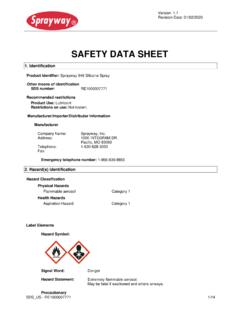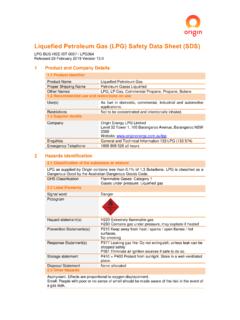Transcription of Material Safety Data Sheet - Sprayway, Inc
1 Version: Revision Date: 09/20/2019 SDS_US - RE1000003396 1/14 Safety data Sheet 1. Identification Product identifier: STAINLESS STEEL POLISH AND CLEANER Other means of identification SDS number: RE1000003396 Recommended restrictions Product Use: Cleaner Restrictions on use: Not known. Manufacturer/Importer/Distributor Information Manufacturer Company Name: Sprayway, Inc. Address: 1000 INTEGRAM DR. Pacific, MO 63069 Telephone: 1-630-628-3000 Fax: Emergency telephone number: 1-866-836-8855 2. Hazard(s) identification Hazard Classification Physical HazardsFlammable aerosol Category 1 Health HazardsSerious Eye Damage/Eye Irritation Category 2A Skin sensitizer Category 1 Specific Target Organ Toxicity - Single Exposure Category 31. Aspiration Hazard Category 1 Target Organs 1. Narcotic effect.
2 Environmental HazardsAcute hazards to the aquatic environment Category 2 Chronic hazards to the aquatic environment Category 2 Hazard Symbol: Label Elements Version: Revision Date: 09/20/2019 SDS_US - RE1000003396 2/14 Signal Word: Danger Hazard Statement: Extremely flammable aerosol. Causes serious eye irritation. May cause an allergic skin reaction. May cause drowsiness or dizziness. May be fatal if swallowed and enters airways. Toxic to aquatic life with long lasting effects. Precautionary Statements Prevention: Keep away from heat, hot surfaces, sparks, open flames and other ignition sources. No smoking. Do not spray on an open flame or other ignition source. Do not pierce or burn, even after use. Wash thoroughly after handling. Wear protective gloves/protective clothing/eye protection/face protection.
3 Avoid breathing dust/fume/gas/mist/vapors/spray. Contaminated work clothing should not be allowed out of the workplace. Use only outdoors or in a well-ventilated area. Avoid release to the environment. Response: IF INHALED: Remove person to fresh air and keep comfortable for breathing. IF IN EYES: Rinse cautiously with water for several minutes. Remove contact lenses, if present and easy to do. Continue rinsing. If eye irritation persists: Get medical advice/attention. IF ON SKIN: Wash with plenty of water If skin irritation or rash occurs: Get medical advice/attention. IF SWALLOWED: Immediately call a POISON CENTER/doctor Do NOT induce vomiting. Call a POISON CENTER/doctor if you feel unwell. Specific treatment (see on this label). Wash contaminated clothing before reuse. Collect spillage. Storage: Protect from sunlight.
4 Do not expose to temperatures exceeding 50 C/122 F. Store in a well-ventilated place. Keep container tightly closed. Store locked up. Disposal: Dispose of contents/container to an appropriate treatment and disposal facility in accordance with applicable laws and regulations, and product characteristics at time of disposal. Hazard(s) not otherwise classified (HNOC): None. Version: Revision Date: 09/20/2019 SDS_US - RE1000003396 3/14 3. Composition/information on ingredients Mixtures Chemical Identity CAS number Content in percent (%)* Distillates (petroleum), hydrotreated light 64742-47-8 25 - <50% White mineral oil (petroleum) 8042-47-5 20 - <50% propane 74-98-6 10 - <20% 2-Propanone 67-64-1 10 - <20% Acetic acid, methyl ester 79-20-9 5 - <10% Terpenes and Terpenoids, sweet orange-oil 68647-72-3 - <1% 2,6-Octadienal, 3,7-dimethyl- 5392-40-5 - <1% * All concentrations are percent by weight unless ingredient is a gas.
5 Gas concentrations are in percent by volume. 4. First-aid measures Ingestion: Call a physician or poison control center immediately. Rinse mouth. Never give liquid to an unconscious person. If vomiting occurs, keep head low so that stomach content doesn't get into the lungs. Inhalation: Move to fresh air. Skin Contact: Get medical attention if symptoms occur. Destroy or thoroughly clean contaminated shoes. Immediately remove contaminated clothing and shoes and wash skin with soap and plenty of water. If skin irritation or an allergic skin reaction develops, get medical attention. Eye contact: Immediately flush with plenty of water for at least 15 minutes. If easy to do, remove contact lenses. Get medical attention. Most important symptoms/effects, acute and delayed Symptoms: No data available. Hazards: No data available.
6 Indication of immediate medical attention and special treatment needed Treatment: No data available. 5. Fire-fighting measures General Fire Hazards: Use water spray to keep fire-exposed containers cool. Fight fire from a protected location. Move containers from fire area if you can do so without risk. Suitable (and unsuitable) extinguishing media Version: Revision Date: 09/20/2019 SDS_US - RE1000003396 4/14 Suitable extinguishing media: Use fire-extinguishing media appropriate for surrounding materials. Unsuitable extinguishing media: Do not use water jet as an extinguisher, as this will spread the fire. Specific hazards arising from the chemical: Vapors may travel considerable distance to a source of ignition and flash back. Special protective equipment and precautions for firefighters Special firefighting procedures: No data available.
7 Special protective equipment for fire-fighters: Firefighters must use standard protective equipment including flame retardant coat, helmet with face shield, gloves, rubber boots, and in enclosed spaces, SCBA. 6. Accidental release measures Personal precautions, protective equipment and emergency procedures: Ventilate closed spaces before entering them. ELIMINATE all ignition sources (no smoking, flares, sparks or flames in immediate area). Keep upwind. See Section 8 of the SDS for Personal Protective Equipment. Do not touch damaged containers or spilled Material unless wearing appropriate protective clothing. Keep unauthorized personnel away. Methods and Material for containment and cleaning up: Absorb spill with vermiculite or other inert Material , then place in a container for chemical waste. Notification Procedures: Prevent entry into waterways, sewer, basements or confined areas.
8 Stop the flow of Material , if this is without risk. ELIMINATE all ignition sources (no smoking, flares, sparks or flames in immediate area). Stop leak if you can do so without risk. Environmental Precautions: Do not contaminate water sources or sewer. Prevent further leakage or spillage if safe to do so. Avoid release to the environment. 7. Handling and storage Precautions for safe handling: Avoid contact with eyes. Wash hands thoroughly after handling. Keep away from heat, hot surfaces, sparks, open flames and other ignition sources. No smoking. Do not spray on an open flame or other ignition source. Do not pierce or burn, even after use. Avoid contact with eyes, skin, and clothing. Conditions for safe storage, including any incompatibilities: Store locked up. Pressurized container: protect from sunlight and do not expose to temperatures exceeding 50 C.
9 Do not pierce or burn, even after use. Aerosol Level 3 8. Exposure controls/personal protection Control Parameters Occupational Exposure Limits Chemical Identity Type Exposure Limit Values Source Distillates (petroleum), REL 100 mg/m3 US. NIOSH: Pocket Guide to Chemical Version: Revision Date: 09/20/2019 SDS_US - RE1000003396 5/14 hydrotreated light Hazards (2005) Distillates (petroleum), hydrotreated light - Non-aerosol. - as total hydrocarbon vapor TWA 200 mg/m3 US. ACGIH Threshold Limit Values (2008) TWA 200 mg/m3 US. ACGIH Threshold Limit Values (2008) White mineral oil (petroleum) - Mist. REL 5 mg/m3 US. NIOSH: Pocket Guide to Chemical Hazards (2005) PEL 5 mg/m3 US. OSHA Table Z-1 Limits for Air Contaminants (29 CFR ) (02 2006) STEL 10 mg/m3 US. NIOSH: Pocket Guide to Chemical Hazards (2005) TWA 5 mg/m3 US.
10 OSHA Table Z-1-A (29 CFR ) (1989) White mineral oil (petroleum) - Inhalable fraction. TWA 5 mg/m3 US. ACGIH Threshold Limit Values (01 2010) propane REL 1,000 ppm 1,800 mg/m3 US. NIOSH: Pocket Guide to Chemical Hazards (2005) PEL 1,000 ppm 1,800 mg/m3 US. OSHA Table Z-1 Limits for Air Contaminants (29 CFR ) (02 2006) TWA 1,000 ppm 1,800 mg/m3 US. OSHA Table Z-1-A (29 CFR ) (1989) 2-Propanone STEL 1,000 ppm 2,400 mg/m3 US. OSHA Table Z-1-A (29 CFR ) (1989) PEL 1,000 ppm 2,400 mg/m3 US. OSHA Table Z-1 Limits for Air Contaminants (29 CFR ) (02 2006) TWA 250 ppm US. ACGIH Threshold Limit Values (03 2015) TWA 750 ppm 1,800 mg/m3 US. OSHA Table Z-1-A (29 CFR ) (1989) STEL 500 ppm US. ACGIH Threshold Limit Values (03 2015) REL 250 ppm 590 mg/m3 US. NIOSH: Pocket Guide to Chemical Hazards (2005) Acetic acid, methyl ester REL 200 ppm 610 mg/m3 US.







